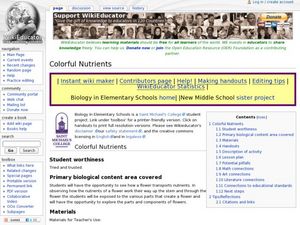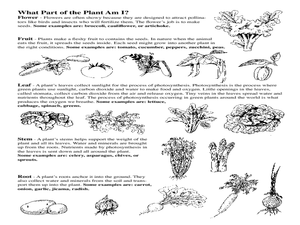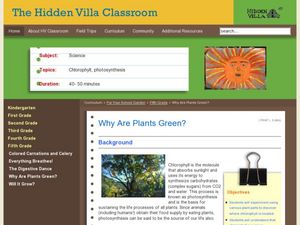Curated OER
Cell-O
Students create model cells using gelatin, toothpicks, and various fruits to represent organelles. Then, students observe their models and complete a Venn Diagram comparing and contrasting plant and animal cells.
Curated OER
Colorful Nutrients
Young scholars participate in an experiment to understand how plants get nutrients. In this plant nutrition, lesson students examine how colored water goes through the stem of a plant to the flower. Young scholars discuss the parts of...
Curated OER
No Title
First graders listen as the book, "Tops and Bottoms," by Janet Stevens is read to them and then participate in a discussion about foods and where they grow. They draw a picture of a plant labeling the major parts of it sequential order.
Curated OER
Parts of a Plant
Students record observations about parts of plants including leaves, roots, stems, and flowers. They use Kid Pix to draw a picture of a plant and to label the parts of the plant.
Curated OER
Plant Cell Coloring
Students study a plant cell and its parts. In this cell organelle lesson students are to label parts of a plant cell and color them.
Curated OER
The Parts of a Plant
In this parts of a flower instructional activity, students draw a flower in the space provided and label the stem, leaves, roots, and flower.
The Science Spot
Flower Basics
Learn about plants and pollination with a worksheet about the parts of a flower. After labeling the anatomy of a flower using a word bank, kids explain the difference between self-pollination and cross-pollination, and unscramble...
Rural Science Education Program
Bees and Flowers – Partners in Pollination
Why are bees so important? After several activities where kids investigate the form and function of flowers, they learn about the different types of bees and label them. They then examine pollen under a microscope and decide which bees...
LABScI
Photosynthesis: How Do Plants Get Energy?
Examine the mechanism of photosynthesis through different light scenarios. Pupils vary the amount and type of light exposure on plant leaves in the fifth lesson plan in a 12-part series. Through observation, they determine the rate of...
Curated OER
Introduction to Plant Reproduction
For this plant reproduction worksheet, high schoolers will label the 9 reproductive structures of moss and fern. Then students will complete 2 short answer questions based on the diagrams they labeled.
Curated OER
Seed to Plant
Young scholars understand the stages of a plants life. In this stages of plant development lesson, students read about bean plants and grow their own. Young scholars record growth and photograph changes in their plants. Students label...
Curated OER
Cell Types and Parts
Eighth graders, after creating a Venn Diagram comparing/contrasting animal and plant cells, writing ten similes describing cell types, or drawing a colored diagram of a cell, list cell types as well as describe and label cell parts. They...
Curated OER
Plant Pipes
Students work together to discover the path water follows in plants. They create multicolored flowers. They label each part of the plant and note their function.
Curated OER
Comparing Plant and Animal Cells
In this comparing plant and animal cell worksheet, learners use a microscope to observe cheek cells and onion cells. They compare their observations and answer 3 questions about their discoveries.
Curated OER
Photosynthesis and Plant Reproduction
Students explain the process of photosynthesis. In this biology lesson, students label the different reproductive parts of the flowers. They watch a short video then identify the leaf parts on the board.
Curated OER
Plant Party
Young scholars identify plant parts. In this plants lesson, students bring in a vegetable. Each student classifies which part of the plant their vegetable comes from (flower, root, ect.) Young scholars identify the parts of their...
Curated OER
Creating a Plant Cell Journal
Fifth graders gather information about plant cells. As they read in their science book about plant cells, they take notes on the important facts. Then, they look at their notes and organize them into an outline before they write their...
Curated OER
Drawing a Plant Cell
For this cell structures worksheet, students draw a plant cell. Students draw and label all of the parts listed in the word bank. Students then identify each part by coloring it the color indicated in the word box.
HudsonAlpha Institute for Biotechnology
iCell
View attractive, three-dimensional models of an animal cell, a bacterium, or a plant cell. Suspended in a translucent, undulating cytoplasm, are all of the major organelles for life science learners to examine. They can zoom in, click on...
Curated OER
Why Are Plants Green?
Students smash plant parts and wait for visibility of chlorophyl to show why plants turn green. In this green plants lesson plan, students use acetone and filter paper for this experiment.
Curated OER
Parts of a Plant - Strawberry Plant
In this plant parts worksheet, students study the picture of the strawberry plant and the terms. Students then label the plant by the correct part.
Curated OER
Helping Plants Grow Well
Young scholars investigate the effect of water, temperature, and light on plant growth. In this plant lesson, students identify the parts of the plant and participate in an online activity. The website is included in this lesson plan.
Curated OER
Plant Parts
Students use "Kid Pix" to explore plants. In this science and technology lesson plan, students become familiar with plant parts and label them on a plant. Students tell the functions of each of the plant parts.
Curated OER
Exploring Plants
Students examine plants using adiotapes, Internet research, and print media. They name the plant parts and discover their functions. Students create computer-generated pictures of their plants and label the parts. Other activities...























